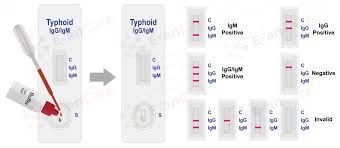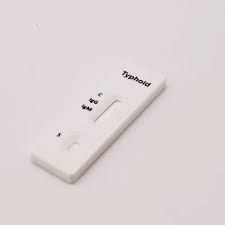Typhoid strips, commonly referred to as typhoid rapid test kits, are diagnostic tools designed to detect the presence of antibodies against Salmonella typhi, the bacterium responsible for typhoid fever. These tests are particularly useful in clinical settings where quick results are needed to guide treatment decisions.
Key Features
- Format: Typically presented as a lateral flow test strip or cassette.
- Specimen Type: The test can be performed using blood, serum, or plasma samples.
- Detection: These tests usually detect both IgM and IgG antibodies, indicating recent or past infection with Salmonella typhi.
Indications
Typhoid rapid test kits are indicated for:
- Diagnosis of Typhoid Fever: They provide a quick screening method to aid in diagnosing typhoid fever, especially in endemic areas.
- Monitoring: Useful for monitoring patients with suspected infections.
Mechanism of Action
The test works by applying a sample to the test strip, which contains antigens specific to Salmonella typhi. If antibodies are present in the sample, they will bind to these antigens, leading to the development of colored lines on the test strip that indicate a positive result.
Usage Instructions
1. Sample Collection: A healthcare professional collects a blood sample via venipuncture or fingerstick.
2. Test Procedure:
- Apply a few drops of the sample to the sample well on the test strip.
- Add the provided buffer solution if required.
- Wait for 15-20 minutes to read the results.
3. Interpreting Results:
- A colored line in the test region (T) indicates a positive result for antibodies against Salmonella typhi.
- A control line (C) must always appear to validate the test; if it does not, the test is considered invalid.
Performance Characteristics
- Sensitivity and Specificity: Rapid tests vary in sensitivity and specificity. For example, some tests have shown sensitivity rates around 72% and specificity rates over 98%, making them more reliable than traditional methods like the Widal test, which has lower sensitivity and specificity.
- Rapid Results: Results can typically be obtained within 15-20 minutes, allowing for timely clinical decision-making.
Precautions
- Limitations: While rapid tests are useful, they should not replace confirmatory testing such as blood cultures, which remain the gold standard for diagnosing typhoid fever.
- Consultation Required: Positive results should be followed up with additional testing and clinical evaluation.


